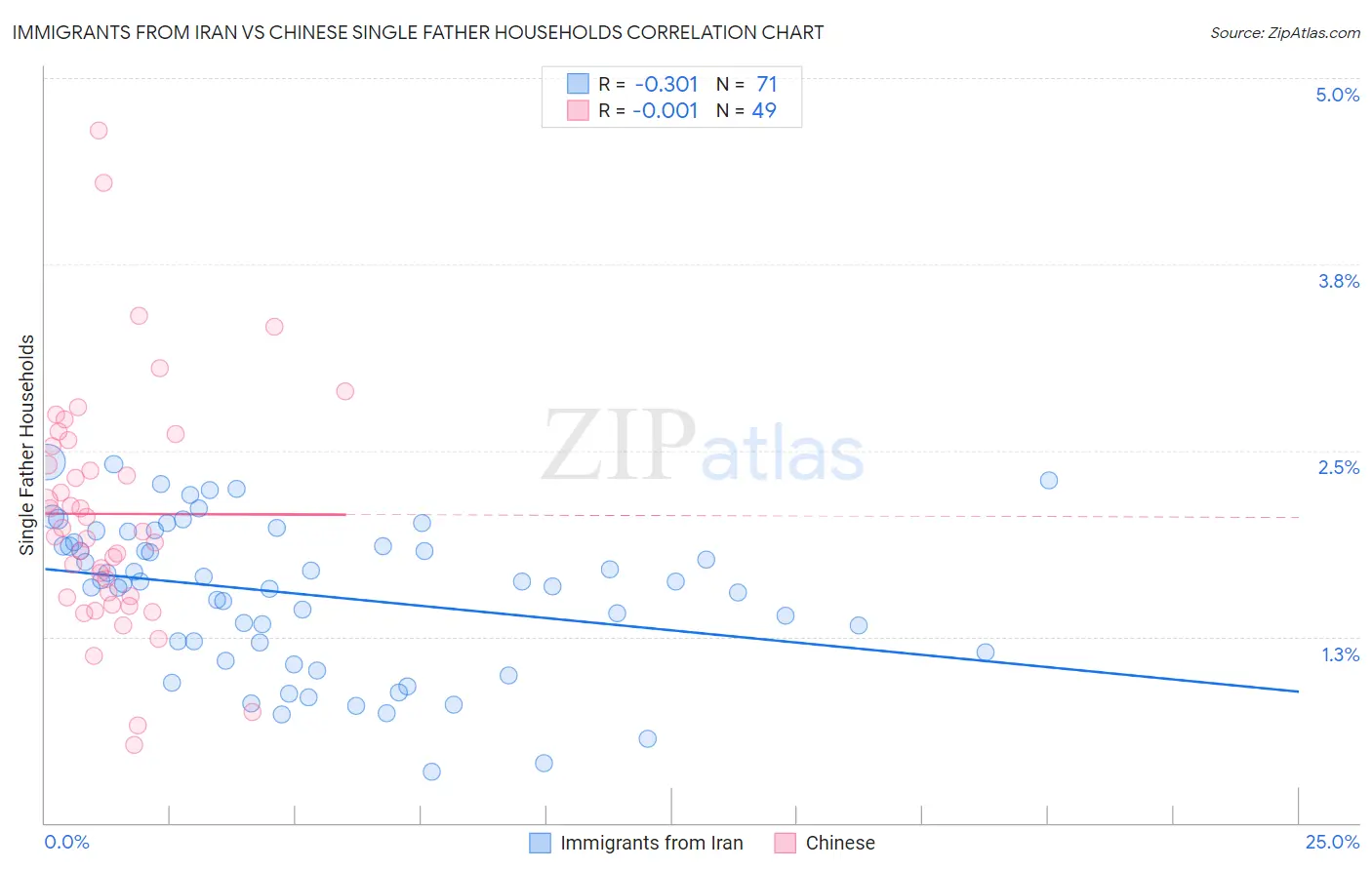Immigrants from Iran vs Chinese Single Father Households
COMPARE
Immigrants from Iran
Chinese
Single Father Households
Single Father Households Comparison
Immigrants from Iran
Chinese
1.9%
SINGLE FATHER HOUSEHOLDS
100.0/ 100
METRIC RATING
16th/ 347
METRIC RANK
2.0%
SINGLE FATHER HOUSEHOLDS
100.0/ 100
METRIC RATING
32nd/ 347
METRIC RANK
Immigrants from Iran vs Chinese Single Father Households Correlation Chart
The statistical analysis conducted on geographies consisting of 278,578,987 people shows a mild negative correlation between the proportion of Immigrants from Iran and percentage of single father households in the United States with a correlation coefficient (R) of -0.301 and weighted average of 1.9%. Similarly, the statistical analysis conducted on geographies consisting of 64,726,791 people shows no correlation between the proportion of Chinese and percentage of single father households in the United States with a correlation coefficient (R) of -0.001 and weighted average of 2.0%, a difference of 4.2%.

Single Father Households Correlation Summary
| Measurement | Immigrants from Iran | Chinese |
| Minimum | 0.34% | 0.52% |
| Maximum | 2.4% | 4.6% |
| Range | 2.1% | 4.1% |
| Mean | 1.5% | 2.1% |
| Median | 1.6% | 2.0% |
| Interquartile 25% (IQ1) | 1.1% | 1.5% |
| Interquartile 75% (IQ3) | 1.9% | 2.6% |
| Interquartile Range (IQR) | 0.74% | 1.0% |
| Standard Deviation (Sample) | 0.50% | 0.81% |
| Standard Deviation (Population) | 0.50% | 0.80% |
Demographics Similar to Immigrants from Iran and Chinese by Single Father Households
In terms of single father households, the demographic groups most similar to Immigrants from Iran are Immigrants from Eastern Asia (1.9%, a difference of 0.20%), Immigrants from India (1.9%, a difference of 0.23%), Immigrants from Lithuania (1.9%, a difference of 0.35%), Indian (Asian) (1.9%, a difference of 0.72%), and Iranian (1.9%, a difference of 1.6%). Similarly, the demographic groups most similar to Chinese are Israeli (2.0%, a difference of 0.040%), Cambodian (2.0%, a difference of 0.070%), Bulgarian (2.0%, a difference of 0.090%), Immigrants from Japan (2.0%, a difference of 0.18%), and Turkish (2.0%, a difference of 0.21%).
| Demographics | Rating | Rank | Single Father Households |
| Immigrants | Lithuania | 100.0 /100 | #14 | Exceptional 1.9% |
| Immigrants | Eastern Asia | 100.0 /100 | #15 | Exceptional 1.9% |
| Immigrants | Iran | 100.0 /100 | #16 | Exceptional 1.9% |
| Immigrants | India | 100.0 /100 | #17 | Exceptional 1.9% |
| Indians (Asian) | 100.0 /100 | #18 | Exceptional 1.9% |
| Iranians | 100.0 /100 | #19 | Exceptional 1.9% |
| Thais | 100.0 /100 | #20 | Exceptional 1.9% |
| Immigrants | Albania | 100.0 /100 | #21 | Exceptional 1.9% |
| Immigrants | Latvia | 100.0 /100 | #22 | Exceptional 1.9% |
| Immigrants | Croatia | 100.0 /100 | #23 | Exceptional 2.0% |
| Immigrants | Russia | 100.0 /100 | #24 | Exceptional 2.0% |
| Eastern Europeans | 100.0 /100 | #25 | Exceptional 2.0% |
| Assyrians/Chaldeans/Syriacs | 100.0 /100 | #26 | Exceptional 2.0% |
| Immigrants | South Central Asia | 100.0 /100 | #27 | Exceptional 2.0% |
| Immigrants | Japan | 100.0 /100 | #28 | Exceptional 2.0% |
| Bulgarians | 100.0 /100 | #29 | Exceptional 2.0% |
| Cambodians | 100.0 /100 | #30 | Exceptional 2.0% |
| Israelis | 100.0 /100 | #31 | Exceptional 2.0% |
| Chinese | 100.0 /100 | #32 | Exceptional 2.0% |
| Turks | 100.0 /100 | #33 | Exceptional 2.0% |
| Immigrants | Australia | 100.0 /100 | #34 | Exceptional 2.0% |